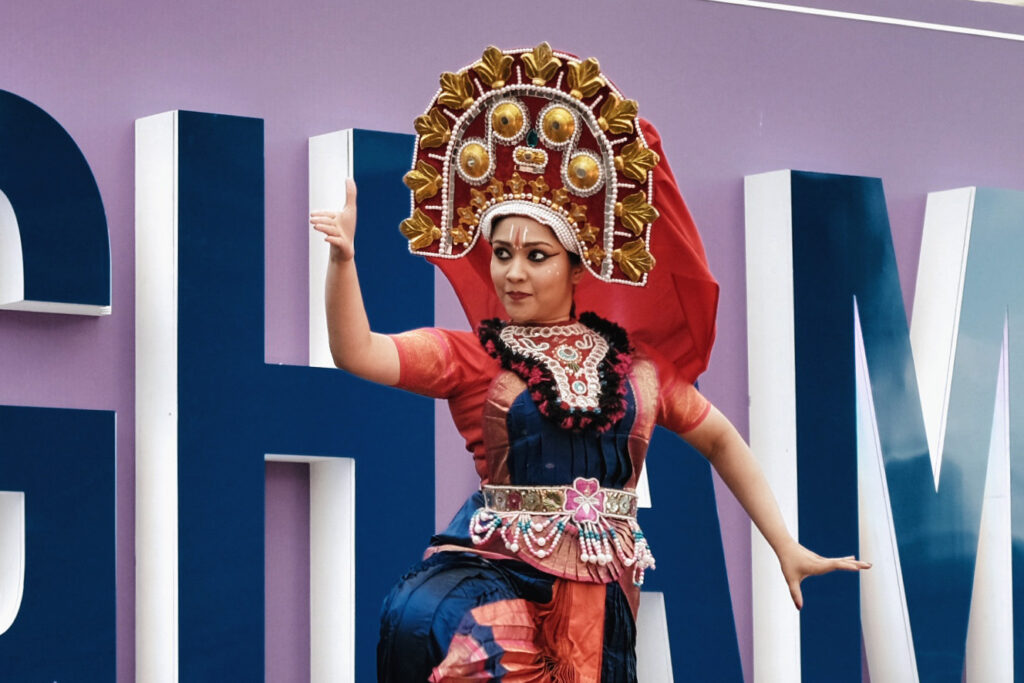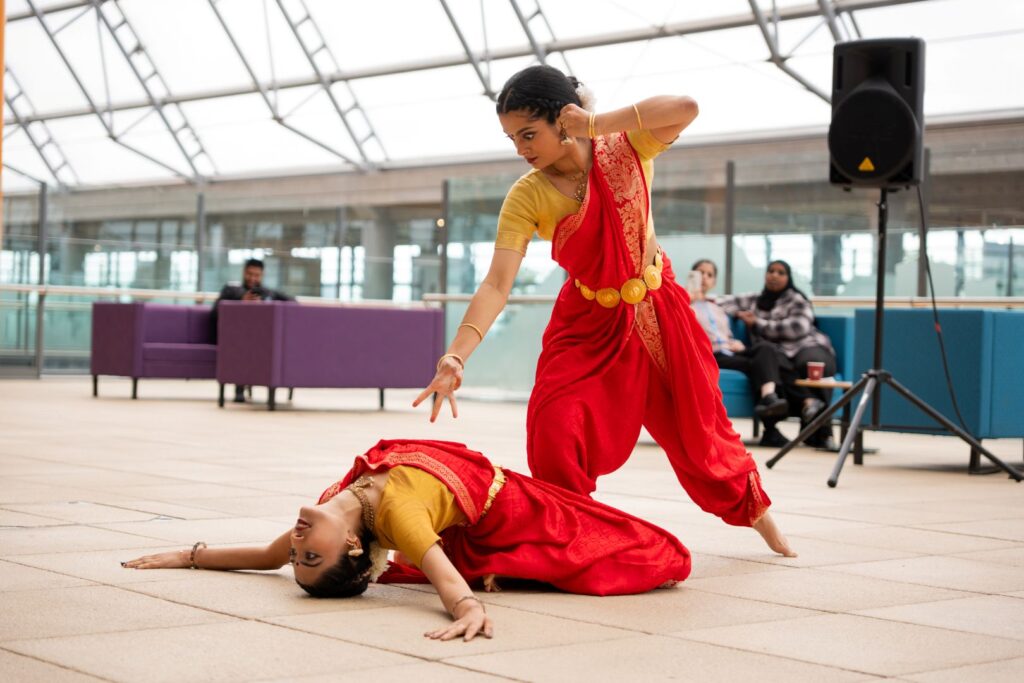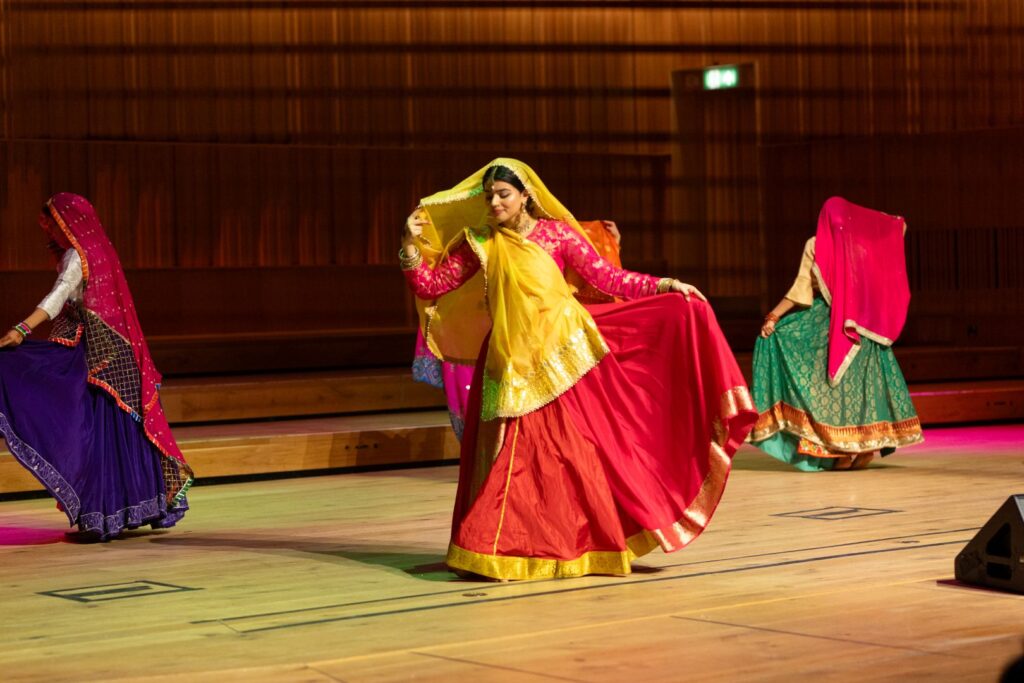Across India, there are diverse classical dance styles, each with a unique heritage. Whilst it would be impossible to share the fullness and richness of every tradition, this blog outlines some key elements to get you started.
To experience these live, book in for Ujala next Wednesday. Join Sampad for an entertaining and joyful evening of dance from across the sub-continent. Tickets available here.
Sattriya
Sattriya hails back to its roots in Assam, India, where it was established by Sankardev in the 15th Century. The dance form was initially created as a part of one act-plays called Bhaona. Today, Sattriya is a key part of the living traditions of Sattras, Hindu monasteries in Assam. It animates ancient texts and stories through expressive dancing, drama and art that is devoted to Krishna. Whilst in the 15th Century it was more commonly performed by men, it is now presented by dancers of all genders and on global stages.

Yakshagana
Yakshagana is a traditional artform and dance originating in Karnataka. The name consists of Yaksha which translates to ‘Demi-God,’ ‘Nature Spirits’ or ‘Celestial’ and Gana which translates to ‘song.’
This unique style is theatrical, featuring colourful, elaborate costumes and make up. It is a sacred and devotional artform which was originally performed in open-air settings and combing ritualistic elements. When performed in traditional contexts and locations such as coastal Karnataka, it is often shared by a troupe of actors and musicians, who can perform from dawn until dusk.

Bharatanatyam
One India’s most traditional dance disciplines, Bharatanatyam originated in the state of Tamil Nadu in southern India. Within the dance are 3 broad elements of: Nritta (the technical element of a performance, with attention to the detail, rhythm and the form of movements); Nritya (an interpretative element, bringing in spiritual and emotional themes and symbolism); and Natya (relating to drama and storytelling that is conveyed through the dance).
A distinctive element of Bharatanatyam is found in the series of mudras, or hand gestures. There are 28 Asamyuta Hastas (one-hand gestures) and 24 Samyuta Hastas (two-hand gestures), each sharing a different meaning, message or idea. Example include the Mayura (Peacock), the Mrugasheersha (Deer’s head) and the Alapadma (Lotus in full bloom).
Odissi
Odissi is one of the oldest surviving classical dances of India, which originated in Odisha, an eastern coastal state. The dance style has historically shared spiritual ideas, messages and religious stories, interpreting ragas and talas of Odissi musicians and poets. Stories of Hindu goddesses are abundant within this dance form, relating to deities such as Shiva and Surya. Within an Odissi performance, you can expect to see the elements of Nritta, Nritya and Natya explored above in other dance styles, as well Mokshya, a final section connecting to salvation and spiritual release.

Kathak
Kathak is often attributed to travelling bards in Northern India in ancient times, called Kathakaars. These storytellers shared tales through song, music and dance. There are 3 distinct forms or Gharana within Kathak, indicating the origin and tradition for each. These are Lucknow, Banares and Jaipur. In this dance, you will find a varied vocabulary and sequence of movements through the neck, upper body, hands and footwork. The eyes are also a key element for conveying story and emotion, with acting and expression playing an important role.
Kuchipudi
Kuchipudi is another ancient dance form from India which, like many others, arose from the Natya Shastra, a treatise on the performing arts that is dated to between 200 BCE and 200 CE. This style originated in the Krishna district of Andhra Pradesh, and combines dance with elements of drama.
The themes of Kuchipudi performances often come from Hindu mythology, and routines tend to start with an invocation to the Gods. The trio of Nritta, Nritya and Natya are also found within this tradition, alongside Abhinaya, the art of storytelling through face expressions and gesture. There are also 8 Rasas, or emotions, which must be conveyed through a Kuchipudi performance.
Ujala comes to Midlands Arts Centre on Wednesday 5th November 2025, providing a mesmerising evening of Indian Classical Dance. It promises to be a brilliant evening out, whether you’re a dance-enthusiasts or looking to try something new. Book your place here.